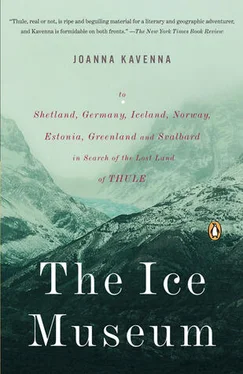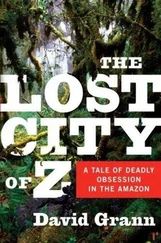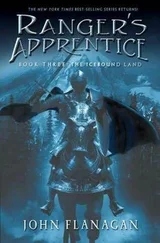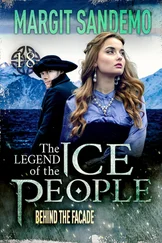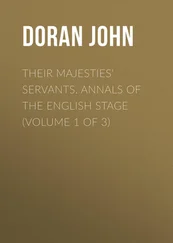Though my parents cried off from further excursions, I plotted darkly for a few years, waiting until I could travel north again. At the age of eighteen I travelled along the coast with a friend in a borrowed car. On the ferry from Britain to Bergen we were ill, the sea churned around the bows, we slept on the deck. We drove from Bergen. Determined to get as far north as possible, we ate on our laps, taking turns at the wheel. Then, from land, the sea was the constant unknowable of the journey, stretching beyond reach. We spent every day driving, moving through the fishing villages and oil towns, the ancient car sluggish around the mountain passes, speeding up in the long tunnels filled with orange headlights.
We camped by the fjords, stewing tins on a campfire each evening, as the sun lingered long in the sky. We woke to the sounds of water crashing down the valley and the cries of birds echoing round the mountains. The roads were almost empty; we stopped occasionally in the oil towns along the way, visiting shabby museums cluttered with fishing nets, admiring the stillness of the twilight. We hiked up mountains, slipping on the scree, scrambling along rock ridges. We camped by the sea; the rock beaches were our daily home, where we struggled to find a place to pitch a tent. The rain fell hard on the roof of the car, punctuating the stillness; the sky was a stolid grey and the clouds formed rain-heavy clumps. The ground lay rigid and sparsely covered, a few tendrils of grass, patches of moss.
The sea was visible in the gaps in the low hills; by the end we were in the ragged northern mountains, where the coastline of Norway turns east towards Russia. The lights flickering on the blackness of the fjords. Sheer mountainsides, as we wound up and down the passes, through tunnels blasted into the rocks. The small wooden houses were reflected in the clear waters of the fjords.
The beauty was unchanged. The first morning onboard, I looked out of my cabin at dawn and saw the fjord sides rising above the boat. The sun was glinting onto the water; through dark clouds the light fell in fine rays across the stacked-up mountains, which receded endlessly into the distance, like the eternal reflections of a hall of mirrors. Ahead there were hundreds more miles of mountains in rows, trembling under the heat haze. The colours stayed the same—the blue sky reflected in the still waters of the fjord, the dark shadows of the mountains in the distance. But the geometry was constantly shifting—curved mountain crags, sharp points, even plateaux, smooth mounds, rugged lumps. The mountains in the foreground stood bold and sharp-featured; as they receded they faded into intimations. One range dispensed with revealed another, looming in the distance; we were steaming towards it, our progress slow against the vastness of the gradients, the immensity of the sky. Even smallness revealed itself as enormity—small mounds in the distance grew gradually as we approached, until we reached them, and found they were imposing peaks.
The fjord sides were scattered with painted wooden houses, in bright colours, to offset the bleak grey of the winter. The boat was moving towards Ålesund, which looked from a distance like a town conjured from a Meccano kit, spray-painted white. Closer in, the white blocks were art nouveau terraces, their stark lines refined by murals and painted façades. A regional anomaly in the land of wooden chalets, it had the feel of an architectural experiment, a crazy scheme, realized out of sight of civilization. As the Germans built Bergen, so they designed the frontages of Ålesund. In January 1904, Ålesund burnt to the ground. Kaiser Wilhelm of Germany sent supplies and provisions to the town, and art nouveau Ålesund was born. The aesthetic has been subdued for the coast—the Jugendstil warriors and maidens with twined tresses replaced with anchors and flowers. The white and grey lines of the buildings slide out towards the jagged Alps of Sunnmøre.
The ship was passing the Romsdal district, where Pytheas first landed, according to Nansen, and was taken on the sunset tour by the barbarians. It was a beautiful place, worthy of a mystery myth or two. The shadow layers of the mountains surrounded the boat, serried peaks adorned with fine feathery waterfalls. The sunlight fell across the trees, flickering through the branches, turning the leaves purple. Low islands loomed out of the water, scattered with scrawny bushes. I sat on the deck, bewildered by the peaks and plateaux, staring at the sharp summits emerging from the dense layers of the rocks. The snow was stacked in thick piles on the tops of the mountains, filling in the hollows in the rocks. The boat moved down Geiranger Fjord, a narrow, steep-sided fjord, the mountains coated with thick firs. The region was, Nansen thought, the best of Norway: ‘A glorious land—I wonder if another fairway like this is to be found the whole world over? Those never-to-be-forgotten mornings, when nature wakens to life, wreaths of mist glittering like silver over the mountains, their tops soaring above the mist-like islands of the sea! Then the day gleaming over the dazzling white snow-peaks! You may shrug your shoulders as much as you like at the beauties of nature, but it is a fine thing for a people to have a fair land.’
Today, the shores would have struck Nansen as positively overpopulated, but he would have been surprised by their indifference—by the soundless small towns sheltering under the crags, with names like Brattvåg and Midsund, the windows of the houses blank. Nothing moved along the shore, as the ship steamed slowly north. The light hit the mountains, harsh and persistent, the trees were slender and parched on the barren islands, and still, nothing moved along the shore.
Molde, where the ship shook to a standstill, was a small place of low concrete houses, ranging up the tree-coated mountainside. Like so many fishing villages along the western coast, it was bombed to the ground during World War Two. Molde’s nemesis came in 1940, as German bombers tried to flush out the king, who was hiding there. There’s an old picture taken during the bombing, of the king and crown prince standing under a birch tree. It’s a poignant image: the royal family, fugitives from Oslo, sheltering from the screaming of the planes as if taking cover from a hailstorm. When the ship docked the lights were on in the town; people were sitting on benches by the quayside, outside the waterside bars, looking up and down at the steamer. It had taken out their view—a relentless succession of stacked-up spikes and crags. The sun faded across a wine-red sea. Lights from the low-rise town were reflected on the water, and boats lined the docks, moored for the night, the wake from the steamer slapping against their hulls. The shadows of the mountains loomed across the water. Drenched in a deep blue dusk, their white tips glinting, and at their base, the sea.
Nansen imagined Pytheas sailing up the coast, finding natives who showed him where the sun went to rest, and experiencing the long days of the summer months. Galvanized by their hospitality, by the strange sights they showed him, he sailed on. A thousand years before the great Norse era, Pytheas sailed through what would become the Viking heritage trail, a source of pride to Nansen. This was one of the regions King Harald Fairhair concentrated his force on, when he unified Norway and sent the rebellious and independent across the seas to Iceland. The ninth-century farmers left their lands, and set sail across the ocean, a trans-European migration of the ruined and hopeful. King Harald stayed, glowering in the west, sending out messages to the remaining landholders, asking why they had not come to see him. The Norwegians of the nineteenth century, examining this great Viking past, felt, a little like the Icelanders in the west, that things had been in perpetual decay since the early medieval era. Since the decline of the Viking Empire, Norway had been constantly under the control of foreign powers—joined with Denmark for centuries, and then with Sweden since 1815. Between Nansen’s first voyage and his account of Norway as Thule the union between Norway and Sweden was dissolved, and Norway became an autonomous country. Northern myths became fodder for independence talk. Nansen proposed the antiquity of his nation, its claim to an old tale about the north. Pytheas might have sailed past the idyllic fjordland north of Bergen, the rocks piled in layers. A fertile land, covered now with farms and dense tree growth—horse chestnuts, maples, holly, linden and copper beech. Pytheas might have passed northwards through the long, serene day of Nordmøre and Romsdal, the mountains by night a retreating pattern of dark blue shadows.
Читать дальше
